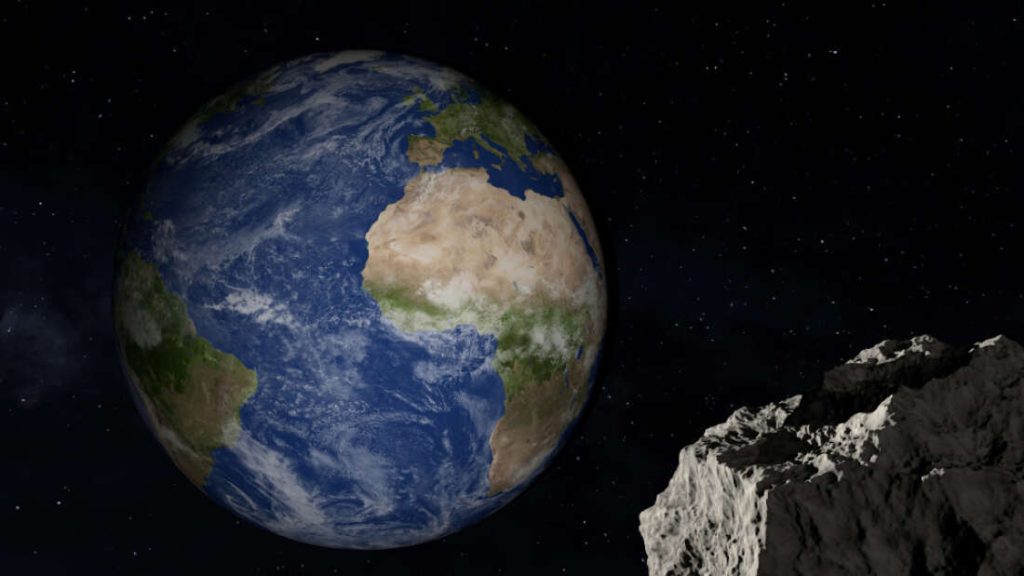A “potentially hazardous” near-Earth asteroid is set to whizz past our planet tomorrow, followed by an even larger one next week – but don’t worry, Earth may be popular right now, but not enough for any of these visiting space rocks to hit us.
Asteroid 418135 (2008 AG33) will be zooming by at around 37,400 kilometers per hour (23,300 miles per hour) – around 30 times the speed of sound – on Thursday, April 28, according to NASA. It will come within 3.2 million kilometers (2 million miles) of Earth, extremely close in cosmic terms, but around eight times the distance of the Moon to us for context.
The asteroid was first discovered back in 2008 and swings past our planet every seven years. It last visited on March 1, 2015, and will zoom past again on May 25, 2029.
It’s estimated to be around 350 to 780 meters (1,150 to 2,560 feet) wide, which on the larger end is around twice the height of the Empire State Building, six Taj Mahals placed on top of each other, or 144 giraffes. We have been known to offer up ferrets as a unit of measurement, so that’s also 2,000 ferrets (end to end) across.
However, it’s nowhere near the largest space rock to carry out an Earthly flyby this year. That may well go to 467460 (2006 JF42) set to zoom past on May 9 at 40,700 km/h (25,300 mph). That space rock is thought to be between 380 and 860 meters (1,247 and 2,822 feet) across – over the height of the Burj Khalifa, the world’s tallest building.
It will then visit us again on May 11, 2023, and is currently predicted to come remarkably close to Earth on May 4, 2159, passing within just 1.1 million kilometers (686,013 miles) of our planet.
NASA’s Center for Near-Earth Studies (CNEOS) keeps an eye on all space rocks that may make a potential close approach to Earth. They are dubbed “potentially hazardous” because although the likelihood of them hitting us is slim, they are in orbits that could – over millennia – evolve to eventually cross Earth’s orbit. Tracking these space rocks helps us not only keep an eye on any getting too close to us but helps us understand how asteroid orbits evolve.
CNEOS tracks any near-Earth objects (NEOs) that orbit the Sun and come within 48 million kilometers (30 million miles) of Earth’s orbit with a size large enough (30-50 meters/98-164 feet) to cause significant damage on Earth.
And if one did get too close? Various projects and missions address that very topic – and not in a Don’t Look Up or Moonfall way.
International governments and space agencies regularly take part in a tabletop exercise on how to deal with incoming space rocks as part of the bi-annual Planetary Defense Conference. Admittedly, Earth hasn’t had much luck so far in deflecting the asteroid, resulting in large chunks of Europe being annihilated and New York city in ruins.
Perhaps we’ll have better luck with NASA’s first planetary defense mission to crash into an asteroid and knock it off course before it can reach us. NASA’s DART mission launched last November and we’ll find out if it works when it arrives at its destination, asteroid Dimorphos, possibly in September this year. China recently announced it is following suit with its own mission to smash into an asteroid in 2025.
Just to be clear, there are no known objects with trajectories that take out Earth currently, but it’s best to be prepared. As NASA puts it: “Planetary defense is finding asteroids before they find us.”
Related article:
Nano enable approaches to achieve the carbon neutrality from cement and concrete
All RNA and DNA Base Types Are Found in Meteorites, Study Claims












